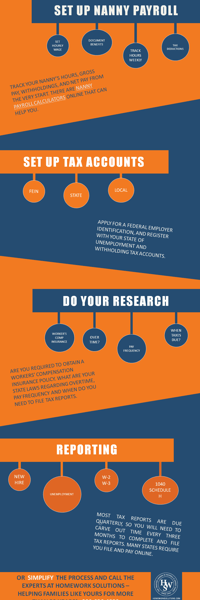For many working parents, finding a hired caregiver/nanny that they trust to be with their children during the workday is extremely important. It may be convenient to pay your nanny under the table, but not only is this illegal, but it can be incredibly costly if you get caught. If you do not pay nanny taxes, there are heft fines and penalties, sometimes ranging upwards of $25,000.
Many families find this both complicated and time consuming. Prefering to dedicate this time to their family, they outsource the nanny payroll to a specialty nanny payroll service like HomeWork Solutions.
If you’re determined to figure out how to pay the nanny taxes yourself, here are the steps on how to pay your nanny legally.
Step #1
Track your nanny’s hours, gross pay, withholdings, and net pay from the very start. There are nanny payroll calculators online that can help you, but these will not help you determine exactly what your filing requirements are as well as what tax filing deadlines there are. In addition, you will need to research and find out how much you will owe for disability, worker’s comp, sick pay, and other benefits that you choose to provide.
Step #2
Apply for a Federal Employer Identification Number (EIN) and ask your nanny to fill out a W-4 and I-9 tax form as soon as possible. The I-9 shows that the nanny is legally able to work in the U.S. and the W-4 is used to figure out how much tax should be withheld from her gross wages each pay period. You cannot proceed past GO without your EIN - it is your master tax identification across the IRS, the Social Security Administration and your state taxing authorities. Properly applied for it will inform the IRS that you are a household employer reporting household employment taxes to the IRS with your annual personal income tax return, and prevent you from the exhaustive process of quarterly 941 filings and annual 940 filings, and corresponding with the IRS to get this corrected.
Step #3
Next, you’ll need to register with your state as an employer. There will be a form that you will need to fill out to apply for an employer registration number. You will need to include an industry SIC code for unemployment tax rate rating and estimate your annual wages or withholding amounts. This is necessary to set up an online account for payment and will insure that quarterly taxes are credited accurately and in a timely fashion.
Service Plans and PricingStep #4
You will then need to fill out a new hire report for your state and you can do this simply by searching online with the following text: “New Hire for State (X). This will notify state agencies that there is a new employee and you will be given proper instructions on how to report. New hire reporting is mandated under federal law and protects the integrity of unemployment tax benefits and other social welfare benefit programs.
Step #5
State laws vary on the compliance items employers must follow. From pay frequency to treatment of overtime to required minimum benefits - you will need to learn household employment laws according to your state.
Research worker’s compensation laws in your state. Laws will vary from requiring coverage to all household workers, to requirements based on hours worked, to optional coverage. However, if the nanny is eligible for worker’s compensation and you do not plan ahead for it, there could be a significant financial risks and penalties for not complying.
Step #6
Next comes the actual reporting and payment of taxes. Most tax reports are due quarterly, so you will need to carve out time every three months to complete and file tax reports. Many states require that you file online, and there are steep penalties for late payments. At the end of every year you will need to accurately complete and file Forms W-2 and W-3 with the Social Security Administration as well as a Form 1040 Schedule H with the Internal revenue service.
The idea of calculating and properly paying nanny taxes seems overwhelming and even confusing for some families – this is why a nanny payroll service is the perfect solution. We can accurately document and pay your nanny or babysitter so you won’t be left in a lurch to pay the penalty of doing it wrong. Contact us today to talk to our team of qualified payroll specialists so we can get you and your nanny set up for accurate tax deductions and efficient payroll distribution.


